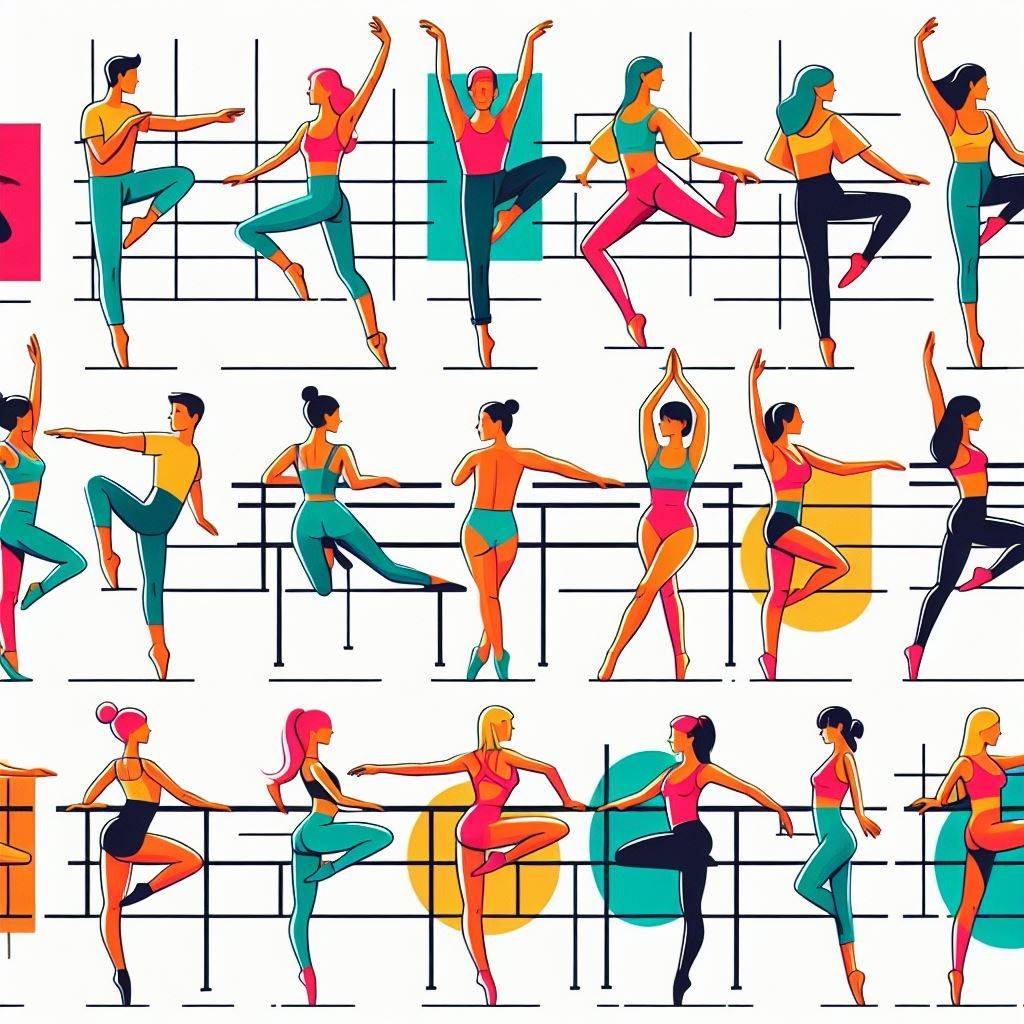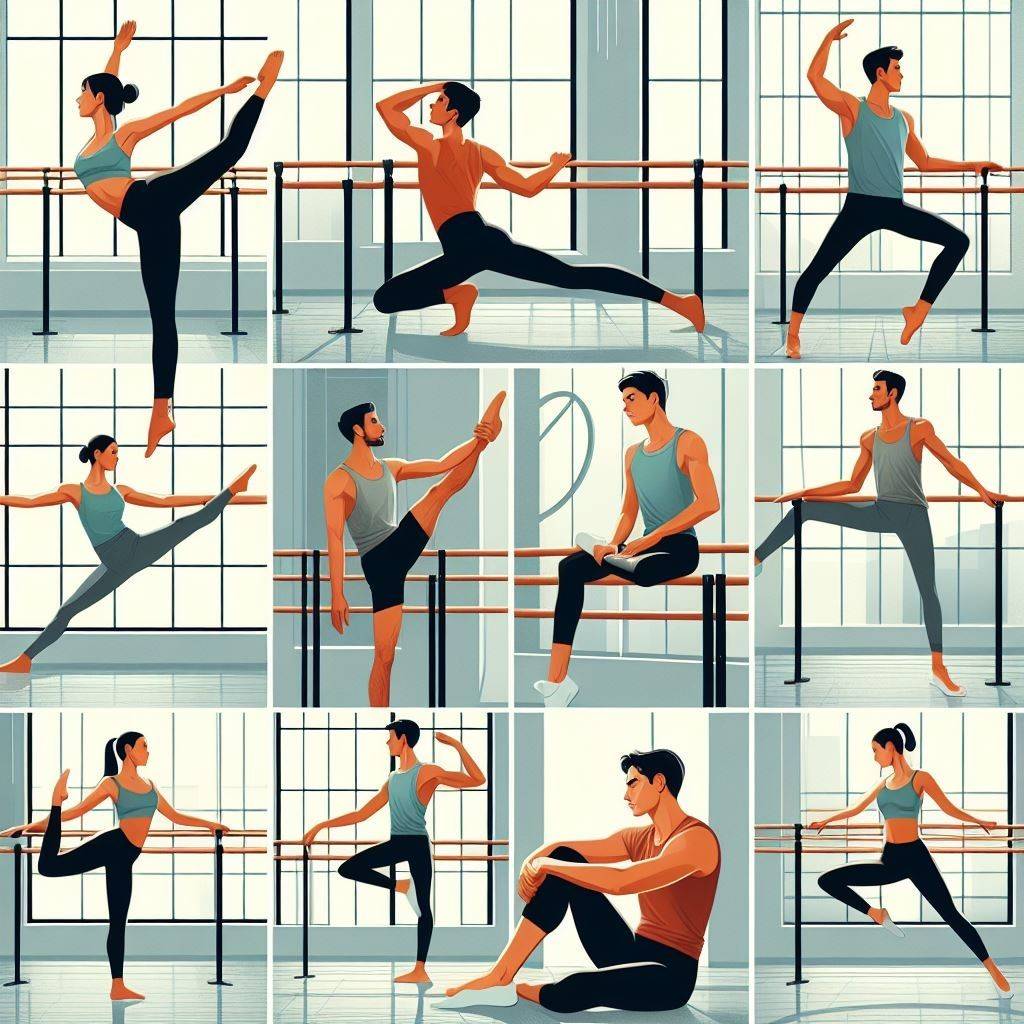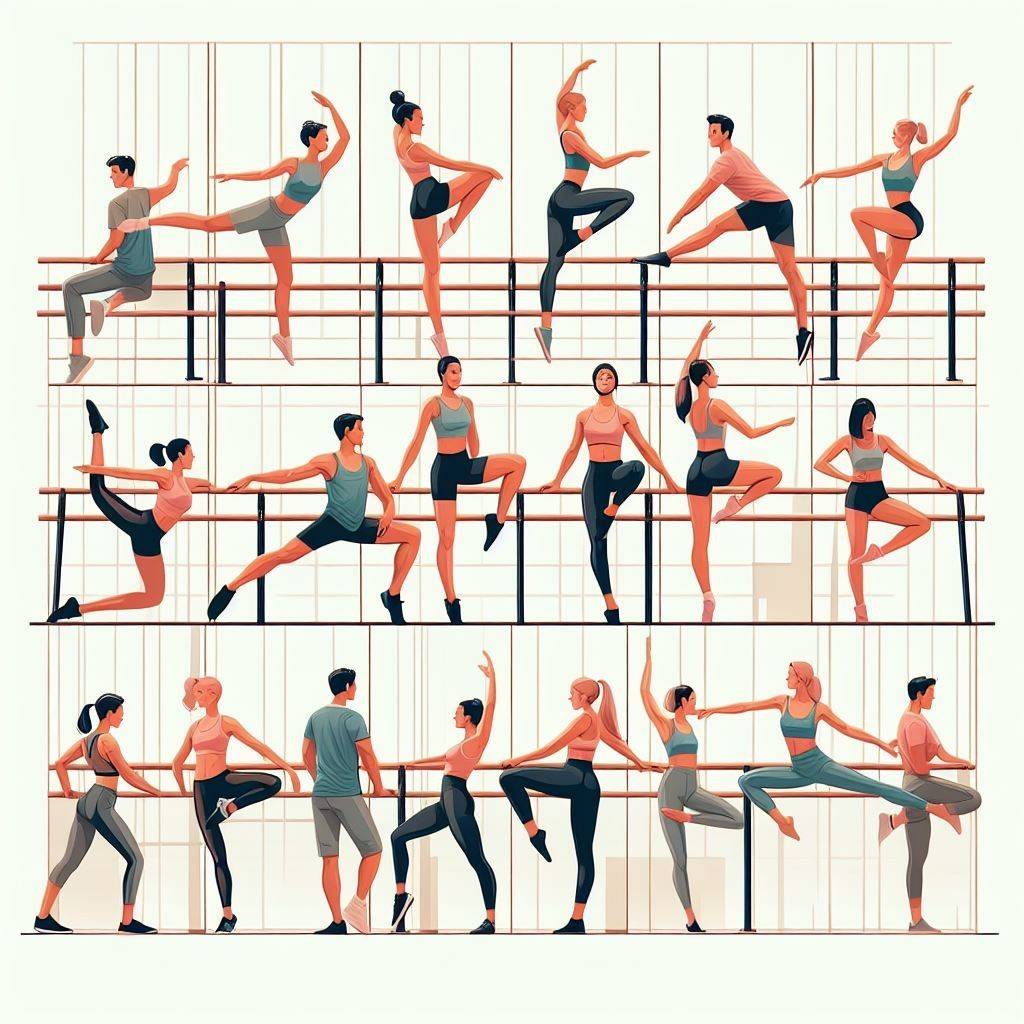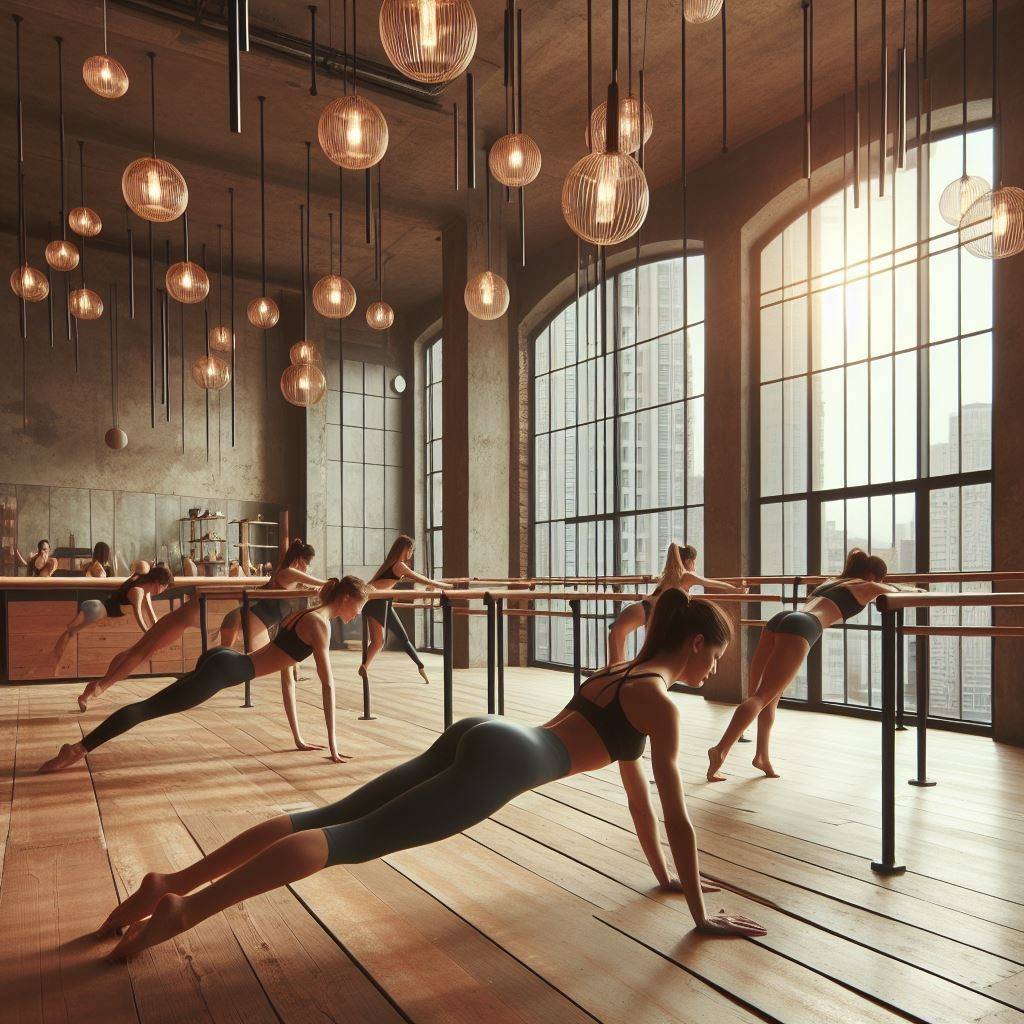Barre Workouts: Tone and Strengthen Your Muscles Gracefully
Elevate your fitness with graceful Barre workouts. Tone and strengthen muscles while embracing ballet-inspired moves.
Key Takeaways
| Benefit | Description |
| Full-Body Toning | Barre workouts target multiple muscle groups for total-body sculpting. |
| Low-Impact, High-Intensity | Small isometric movements provide an effective, low-impact training method. |
| Core Strengthening | Many barre exercises focus on engaging and strengthening the core muscles. |
| Improved Posture and Balance | The ballet-inspired movements help improve overall posture and balance. |
| Increased Flexibility | The deep stretches and controlled movements enhance flexibility. |
| Muscle Lengthening | Barre emphasizes elongating and sculpting lean, toned muscles. |
Are you looking to tone and strengthen your muscles in a graceful, low-impact way? Look no further than barre workouts. This unique fitness routine, inspired by ballet techniques, has taken the world by storm, offering a challenging yet elegant approach to full-body conditioning.
In this comprehensive guide, we’ll explore the benefits of barre workouts, the types of exercises you can expect, and tips for getting started on your journey to a stronger, more sculpted physique.
What are Barre Workouts?
Barre workouts are a fusion of ballet-inspired movements, Pilates, yoga, and strength training exercises. They involve using a waist-high ballet barre for support and resistance, as well as incorporating light weights, resistance bands, and your body weight.
The name “barre” refers to the literal ballet barre used in the workout, but it also reflects the focus on isometric movements – small, controlled motions that engage and challenge your muscles uniquely.
Barre workouts were originally developed by German dancer Lotte Berk in the 1950s as a way for dancers to stay in shape and prevent injuries. Today, these workouts have gained immense popularity among fitness enthusiasts of all levels, offering a fun and effective way to tone and sculpt the body.
Benefits of Barre Workouts
-
Full-Body Toning
One of the key benefits of barre workouts is their ability to target multiple muscle groups simultaneously. From your arms and shoulders to your legs, glutes, and core, these workouts challenge and sculpt your entire body, resulting in a lean, toned physique.
-
Low-Impact, High-Intensity
Unlike many high-impact exercises that can be hard on your joints, barre workouts are low-impact yet incredibly challenging. The small, isometric movements may not seem like much at first, but they engage your muscles in a way that leads to a serious burn and significant strength gains over time.
-
Core Strengthening
Strong core muscles are essential for overall body strength and stability, and barre workouts place a heavy emphasis on engaging and strengthening the core. Many exercises involve balancing on one leg or holding challenging positions, challenging your abdominal muscles to the max.
-
Improved Posture and Balance
The ballet-inspired movements in barre workouts are designed to improve your posture and balance. By focusing on proper alignment and engaging your core, you’ll not only look taller and more confident, but you’ll also reduce your risk of injury in daily activities.
-
Increased Flexibility
In addition to strength and toning, barre workouts incorporate deep stretches and controlled movements that enhance your overall flexibility. This not only helps prevent injuries but also improves your range of motion for everyday activities and other fitness pursuits.
- Muscle Lengthening
Unlike many strength training programs that emphasize bulking up, barre workouts focus on elongating and sculpting lean, toned muscles. This results in a long, lean, and graceful physique, like the aesthetic of a dancer.
What to Wear for Barre
When it comes to barre workouts, it’s essential to wear comfortable and form-fitting clothing that allows you to move freely and allows your instructor to observe your form. Here are some recommendations for what to wear:
- Leggings or Tights: Opt for stretchy, form-fitting leggings or tights made from moisture-wicking fabric. This will allow your instructor to see your leg and glute engagement during exercises.
- Fitted Tank Top or T-Shirt: A fitted tank top or t-shirt made from breathable material is ideal for barre workouts. It should be long enough to avoid riding up during movements but not too baggy, which can obstruct your instructor’s view of your form.
- Sticky Socks or Grip Socks: Barre workouts often involve balance and stability exercises, so sticky or grip socks with non-slip soles are essential for maintaining traction on the floor or barre.
- Sports Bra: A supportive sports bra is a must for women, as barre workouts involve a lot of upper-body movements and core engagement.
- Layering Options: Barre studios can sometimes be chilly, so it’s a good idea to bring a lightweight jacket or sweater to wear before and after class.
Avoid wearing loose or baggy clothing, as it can get in the way during exercises and make it harder for your instructor to correct your form. Additionally, make sure to wear clothing that you feel comfortable and confident in, as barre workouts often involve movements that require a full range of motion.
Types of Barre Exercises

Barre workouts incorporate a variety of exercises, each targeting specific muscle groups and offering unique challenges. Here are some of the most common types of exercises you can expect:
- Pliés
These are the signature barre exercises, inspired by the classic ballet plié movement. They involve bending the knees and lowering them into a squat-like position, targeting the quadriceps, hamstrings, and glutes.
- Relevés
Relives are calf raises performed at the barre, challenging your calf muscles, and improving balance.
- Leg Lifts
These exercises involve lifting and extending your legs in various directions, working your inner and outer thighs, glutes, and core.
- Arm Exercises
From small, controlled arm movements with light weights to exercises focusing on the back and shoulder muscles, barre workouts incorporate a variety of arm exercises for upper-body toning.
- Abdominal Work
Core work is a crucial component of barre workouts, with exercises like planks, leg lifts, and controlled twists targeting the abdominal muscles from every angle.
- Stretching and Flexibility Work
Each barre class typically includes stretches and flexibility exercises, often inspired by yoga and ballet, to improve the range of motion and prevent injuries.
How to Warm Up for a Barre Workout

Proper warm-up is essential before any exercise routine, and barre workouts are no exception. A good warm-up prepares your body for the challenging movements and helps prevent injuries. Here’s how you can warm up for a barre workout:
- Light Cardio: Start with 5-10 minutes of light cardio, such as jogging in place, jumping jacks, or high knees. This will help raise your heart rate and increase blood flow to your muscles.
- Dynamic Stretches: Incorporate dynamic stretches that mimic the movements you’ll be doing in your barre workout. These can include leg swings, arm circles, and torso twists. Dynamic stretches help improve mobility and range of motion.
- Mobility Exercises: Barre workouts require a lot of hip, ankle, and shoulder mobility. Perform exercises like hip circles, ankle rotations, and arm sweeps to prepare these areas for the upcoming workout.
- Pliés and Relevés: Once your muscles are warmed up, practice some basic barre movements like pliés (bending the knees outward) and relevés (calf raises). Start with a few reps at a lower intensity to prime your muscles for the more challenging versions during the workout.
- Core Activation: Engage your core by performing exercises like planks, leg lifts, or hollow body holds. A strong, stable core is crucial for proper form and alignment during barre exercises.
- Breathing Exercises: Take a few moments to focus on your breathing, inhaling and exhaling deeply. This will help you become more aware of your breath and prepare you for the mind-body connection required in barre workouts.
Remember, the warm-up should gradually increase in intensity, but it shouldn’t leave you feeling overly fatigued before the main workout. Adjust the duration and intensity of your warm-up based on your fitness level and the specific class you’ll be taking.
By taking the time to properly warm up, you’ll not only reduce your risk of injury but also set yourself up for a more effective and enjoyable barre workout.
Getting Started with Barre Workouts
If you’re new to barre workouts, it’s important to start slow and focus on proper form to avoid injuries and gain the most benefits. Here are some tips for getting started:
- Find a Qualified Instructor
While there are many online barre workout videos available, it’s best to start with an experienced instructor who can guide you through the proper form and technique. Look for certified barre instructors or studios in your area.
- Invest in the Right Equipment
While you don’t need a lot of equipment for barre workouts, having a few basic items like a sturdy chair or barre, light weights, and resistance bands can enhance your experience.
- Start with Beginner-Level Classes
If you’re new to barre workouts, start with beginner-level classes or videos to get a feel for the movements and avoid overexerting yourself. As you gain strength and confidence, you can progress to more advanced levels.
- Listen to Your Body
Barre workouts can be intense, especially if you’re new to this type of exercise. Listen to your body, and don’t push yourself too hard, too soon. It’s better to start slowly and gradually increase your intensity over time.
- Be Patient and Consistent
As with any new fitness routine, it takes time and consistency to see results from barre workouts. Be patient and stick with it, and you’ll soon start to notice improvements in your strength, flexibility, and overall physique.
Tips for Staying Safe During Barre
Barre workouts are generally low impact, but they still involve challenging movements that can put stress on your muscles and joints if not performed correctly. Here are some tips to help you stay safe during your barre classes:
- Listen to Your Body: If you feel any sharp pain or discomfort during an exercise, stop immediately and inform your instructor. It’s better to take a break or modify the movement than risk injury.
- Proper Form is Key: Barre movements require precise form and alignment to target the correct muscles and prevent strain on your joints. Always prioritize proper form over going deeper into a movement or using heavier weights.
- Warm-Up and Cool-Down: A proper warm-up and cool-down are essential for preparing your body for the workout and preventing injuries. Arrive early to class participate in the warm-up and stay for the final stretches and cool down.
- Use Modifications When Needed: Don’t be afraid to ask your instructor for modifications or alternative exercises if you have any limitations or injuries. Barre workouts can be adjusted to accommodate various fitness levels and concerns.
- Stay Hydrated: Barre workouts can be deceptively challenging, and you may sweat more than you realize. Make sure to drink plenty of water before, during, and after your class to avoid dehydration.
- Gradually Increase Intensity: If you’re new to barre or returning after a break, don’t push yourself too hard too soon. Gradually increase the intensity and duration of your workouts to avoid overuse injuries.
- Cross-Train and Rest: While barre workouts provide a well-rounded fitness routine, it’s still important to cross-train with other activities and allow for adequate rest and recovery between intense sessions.
By following these tips and listening to your body, you can enjoy the benefits of barre workouts while minimizing the risk of injury.
Sample Barre Workout Routine

To give you a better idea of what a barre workout might look like, here’s a sample routine you can try at home or in a studio:
- Warm-Up (5-10 minutes)
- Gentle stretches and mobility exercises
- Light cardio to raise your heart rate.
- Arm Sequence (10-15 minutes)
- Arm circles with light weights.
- Bicep curls
- Triceps kickbacks
- Shoulder raises
- Leg and Glute Sequence (20-25 minutes)
- Pliés with heel raises.
- Leg lifts (front, side, and back)
- Calf raises (relevés)
- Glute bridges
- Core Work (10-15 minutes)
- Planks (forearm and high)
- Leg lifts with abdominal engagement.
- Oblique twists
- Stretching and Cool-Down (5-10 minutes)
- Deep stretches for major muscle groups
- Breathing exercises and relaxation
Remember, this is just a sample routine, and your actual barre workout may vary depending on the instructor or program you follow. The key is to focus on proper form, engage your muscles, and challenge yourself within your limits.
Complementary Activities
While barre workouts offer a well-rounded fitness routine, incorporating complementary activities can further enhance your overall physical fitness and prevent overuse injuries. Here are some activities that pair well with barre:
| Activity | Benefits |
| Yoga | Improves flexibility, balance, and mindfulness. |
| Pilates | Strengthens the core and improves posture. |
| Light Cardio (Walking, Cycling) | Supports cardiovascular health and endurance. |
| Strength Training | Builds overall muscle strength and bone density. |
By combining barre workouts with these complementary activities, you’ll create a balanced fitness routine that targets all aspects of your physical health and wellness.
Barre Workout Etiquette
Like any group fitness class, there are certain etiquette guidelines to follow during barre workouts to ensure a positive experience for everyone involved. Here are some tips:
- Arrive on time or a few minutes early to set up your equipment and avoid disrupting the class.
- Inform the instructor of any injuries or limitations before class begins.
- Avoid wearing strong perfumes or colognes, as some people may be sensitive to scents.
- Respect the personal space of other participants and avoid encroaching on their area.
- Follow the instructor’s guidance and don’t attempt advanced exercises unless you’re confident in your ability.
- Stay focused and avoid distracting conversations during the workout.
- Be mindful of your surroundings and avoid blocking others’ view or access to the barre.
- Clean up after yourself and return any equipment or props to their designated areas.
By following proper etiquette, you’ll create a respectful and enjoyable environment for everyone in the barre studio.
Conclusion
Barre workouts offer a unique and effective way to tone and strengthen your muscles while improving flexibility, posture, and balance. By combining elements of ballet, Pilates, and strength training, these low-impact yet challenging workouts provide a full-body workout that sculpts long, lean muscles and enhances overall grace and poise.
Whether you’re a fitness enthusiast seeking a new challenge or a beginner looking to explore a different form of exercise, barre workouts can be tailored to your fitness level and goals. With proper form, consistency, and the guidance of a qualified instructor, you can experience the transformative benefits of this graceful and empowering fitness practice.
Remember to start slowly, listen to your body, and be patient as you embark on your barre journey. With dedication and perseverance, you’ll soon find yourself standing taller, feeling stronger, and moving with newfound elegance and confidence.



